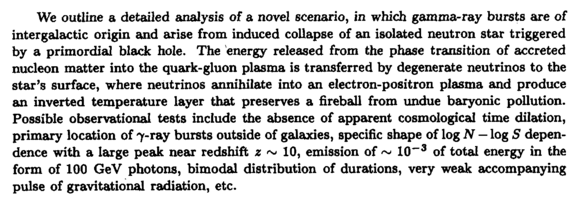|
|

| VOLUME 70 (1999) | ISSUE 10 |
PAGE 642
|
Cosmological γ-ray bursts from collapse of a neutron star induced by a primordial black hole
Derishev E.V., Kocharovsky V.V., Kocharovsky Vl.V.
ID: 04.40.Dg, 97.60.Jd, 98.70.Rz
We outline a detailed analysis of a novel scenario, in which gamma-ray bursts are of intergalactic origin and arise from induced collapse of an isolated neutron star triggered by a primordial black hole. The energy released from the phase transition of accreted nucleon matter into the quark-gluon plasma is transferred by degenerate neutrinos to the star's surface, where neutrinos annihilate into an electron-positron plasma and produce an inverted temperature layer that preserves a fireball from undue baryonic pollution. Possible observational tests include the absence of apparent cosmological time dilation, primary location of 7-ray bursts outside of galaxies, specific shape of log N — log S dependence with a large peak near redshift г ~ 10, emission of ~ 10-3 of total energy in the form of 100 GeV photons, bimodal distribution of durations, very weak accompanying pulse of gravitational radiation, etc.
|
|


 Home
Home